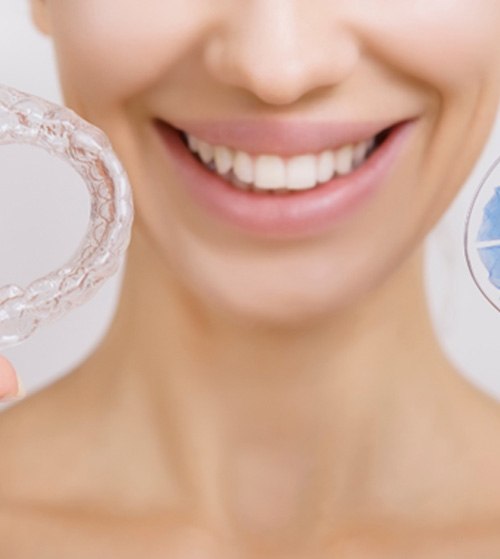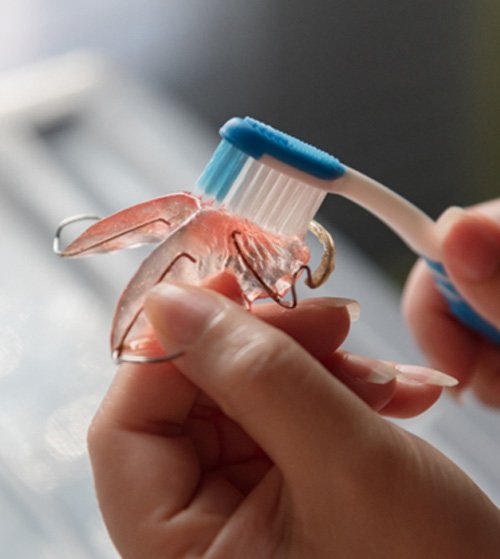Retainers – Plano, TX
Permanent Results Using Trusted Retainers
At Willow Bend Orthodontics of Plano, we are always excited when the day arrives for a patient to have their braces removed. After all, it can be a refreshing realization that the brackets and wires or clear aligners no longer have to be normalcy! With that said, the removal of these orthodontic appliances comes the necessary component of adding a retainer. If you’re ready to learn more about the type of retainer you will need as well as if it will be covered by dental insurance , contact our office and schedule a consultation with our orthodontists , Dr. Jones and Dr. Amerson, today.
The Importance of Retainers

After investing your valuable time and money in braces, the last thing you want is for your teeth to move out of place. That’s where retainers come in. Vital to the ultimate success of a person’s new smile, these unique oral appliances help to keep teeth firmly in their new location, preventing pearly whites from shifting out of alignment and back into their original spot.
Different Types of Retainers

At Willow Bend Orthodontics, we offer our patients several types of retainers. Here’s a little more information about each:
Standard Hawley or Wrap

If you started treatment with a normal overbite, you will likely need to wear a standard Hawley or wrap retainer when finished. These oral devices are created using an impression or digital scan of your smile and can be an ideal solution should you need to wear a retainer long term. It is true that they are more expensive and require more frequent adjusting, and they can break easily if you’re not careful. However, this type of retainer is a great option if you notice your facial muscles and jaw moving with your bite. If you were to wear a retainer that does not allow for adjustability, you could suffer from bruxism and cause wear and tear to your teeth.
A key takeaway with this type of orthodontic retention is that with proper care and maintenance, your retainer can last a long time. Yes, if you’re not being mindful, it can break, but the acrylic used to create your retainer will not stretch over time, allowing for a longer-lasting solution.
Anterior Biteplate

Similar in appearance to the Hawley retainer, an anterior biteplate is created using clear thermoformed plastic and is an ideal option for patients who have a significant overbite or lower incisors that are “overly-erupted.” If you clench or grind your teeth and have strong facial muscles, this device will help to keep your front teeth firmly in place while making sure your posterior teeth have plenty of room to push through.
Typically, we don’t recommend wearing this type of retainer all the time, as your posterior teeth can erupt unevenly. This is why only individuals with a deep bite will benefit most from receiving an anterior biteplate.
Posterior Occlusal Coverage

Should you receive treatment for an anterior open bite or vertical growth pattern, Dr. Jones and Dr. Amerson will likely recommend a posterior occlusal coverage retainer. Designed to be worn on the top or bottom row of teeth, it looks similar to a splint and does require that your orthodontist adjust it when ready for placement. You’ll be pleased to know that with this type of retainer, you will enjoy greater stability. Also, if your teen requires a posterior occlusal coverage retainer, it may help to regulate their vertical changes if there is any potential for underlying growth.
Plastic Full Coverage

A plastic full coverage retainer is made of clear plastic after obtaining a digital scan of your teeth. Whether you have a missing tooth or are simply starting the restorative phase of treatment after completing orthodontics, a plastic full cover retainer is a great option. However, with these come the realization that the plastic can stretch over time, resulting in necessary replacements. The good news is that because of its clear appearance, it will be unlikely for anyone to notice you are wearing it.
Splints

If the reason for your initial orthodontic treatment included issues with the positioning of your jaw, a splint can help to ensure that it along with your facial muscles and bite alignment remain in place. Offering full coverage, it is great if you need long-term retention to maintain a healthier, more beautiful smile.
Caring for Your Retainer

Of course, if your retainer gets crusty and smelly, the chances of you wearing it consistently plunges. To prevent that from happening, we recommend:
- Using a soft-bristled toothbrush to clean your retainer each morning and evening
- Storing your retainer in a protective case when you aren’t wearing it
- Soaking your retainer in a dentist-recommended cleaner each evening
- Not using hot water when cleaning your retainer
- Replacing your retainer at the earliest sign of damage
Retainers FAQs
How Often Do I Need to Wear My Retainer?
Oftentimes, patients are asked to wear their retainers around the clock for several weeks. That way, their teeth have time to “set” in place. If that’s the case for you, then you will need to get the green light from our orthodontist in Plano before transitioning to wearing it solely at night. To preserve your hard-earned results, it’s important that you make putting yours on before bed a lifelong habit.
What Should I Do If I Break My Retainer?
If you break your retainer, do NOT try a DIY solution, like superglue. Instead, call us ASAP. From there, we can schedule an appointment and walk you through what to do in the meantime, like storing it temporarily in a small, clean container. At our office, we can take a look at your retainer and determine if we can repair it. If the answer is “no,” don’t worry – we can have a new one made right away to prevent your teeth from drifting out of alignment.
Can I Drink Coffee with My Retainer?
No, you should not drink coffee while wearing your retainer. There are a few reasons for this, starting with the fact that it can cause stubborn stains to surface on your teeth and your orthodontic appliance. Instead, we recommend taking it off, rinsing it with clean, cool water, and storing it in its designated case beforehand.
What Will Happen If I Don’t Wear My Retainer?
The less you wear your retainer, the more likely it is that you will experience orthodontic relapse. If you aren’t sure what that is, it’s the phenomenon when teeth move back into their previously misaligned positions following orthodontic treatment. Since this happens to upwards of 50% of patients, it’s of the utmost importance that you make wearing your retainer each night a priority.
Can I Use My Old Retainer to Straighten My Teeth?
Retainers are designed to keep your teeth in their properly aligned positions, not move them. So, if you are no longer happy with your smile, the best thing to do is schedule an appointment with our team at Willow Bend Orthodontics of Plano! The sooner you do, the sooner we can review your treatment options and determine the best way to give you the results you desire. Even if the answer is traditional braces, there’s a good chance that your teeth-straightening journey will be shorter this time around.
How Often Should I Replace My Retainer?
The lifespan of your retainer will depend largely on how well you care for it. That’s why we highly recommend incorporating healthy habits into your daily routine, like using a damp, soft-bristled toothbrush to clean yours each morning and night. With all of that said, you should bring yours in for a retainer check every few years (or sooner if it breaks). That way, we can examine its condition and determine if it’s time to have a new one made.

